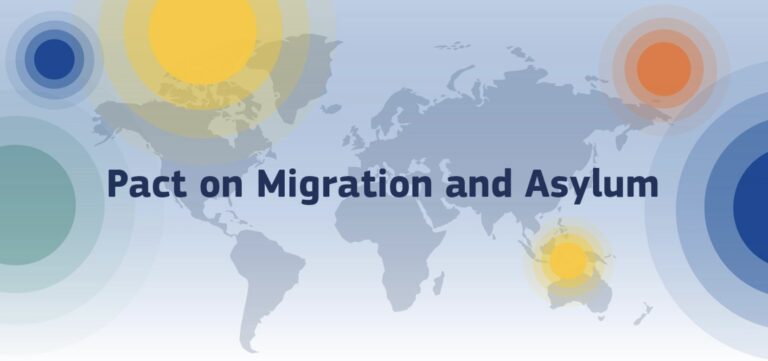“The EU New Pact on Migration and Asylum: Vocational Education and Training (VET)”
Beatrice Romana Verga
In this article, we will explore the role of Vocational Education and Training (VET) within the EU Pact on Migration and Asylum, as previously introduced in our last article.
How is VET addressed in the context of the Pact on Migration and Asylum?
Vocational Education and Training (VET) for Refugees
The Pact emphasizes the need for Member States to develop tailored educational programs that address refugees’ specific needs, particularly in the context of VET.
This is essential for several reasons:
1. Skill Development and Employability
Many refugees bring diverse skills, qualifications and work experiences; however, these may not be recognized in their host country or may not align with local labor market demands. VET programs equip refugees with practical and marketable skills in high-demand sectors — such as healthcare, construction and IT —, enhancing their employment prospects.
2. Bridging Skills Gaps
Many refugees originate from countries with differing educational systems or contexts with limited access to education. VET plays a fundamental role in addressing these gaps, providing pathways to gain qualifications and certifications that are recognized in the EU.
3. Language Acquisition
Many VET programs incorporate language training, which is essential for refugees to communicate in the workplace and integrate into society. A strong command of the local language is essential for professional success and social participation.
4. Tailored Support
The Pact calls on EU countries to tailor VET programs to refugees’ diverse and unique backgrounds and specific needs, including support for young refugees, individuals with disabilities and those with limited formal education. Many of them may also need additional help in terms of language proficiency or understanding the local job market.
Key Measures in the Pact
- Fast-tracking recognition of qualifications: the Pact urges Member States to expedite the recognition of refugee’s qualifications, ensuring that their skills are formally acknowledged and can facilitate access to vocational training programs and to employment.
- Integration into existing VET systems: refugees should be integrated into host countries’ existing VET systems through flexible pathways that recognize their prior qualifications and life experiences. This could include providing opportunities for apprenticeships or internships as a way of gaining valuable on-the-job experience.
- Support for trainers and employers: the Pact advocates strengthening the capacity of VET providers, employers and training staff to better support refugees’ specific needs. This includes offering specialized training to trainers on intercultural communication and refugee-related issues.
EU-Level Initiatives to Support VET and HE for Refugees
The EU has several initiatives designed to support refugees in accessing VET and HE, which align with the Pact’s objectives.
A key initiative is the Erasmus+ Programme, a flagship EU program for education, training, youth and sport. It offers mobility and exchange opportunities for students, including refugees, which can receive scholarships, take part in exchange programs, and gain experience in various educational settings within the EU.
Another initiative is the European Qualification Framework (EQF), which is a common European reference framework that aims to make qualifications more transparent and comparable across EU countries. This can help refugees to better understand how their skills and qualifications can be recognized and transferred across borders within the EU.
Moreover, the European Social Fund+ (ESF+) provides funding for projects related to employment, social inclusion, and education. This includes programs specifically targeting refugees, focusing on integrating them into the labor market through education and skills development.
Conclusion
The Pact on Migration and Asylum places significant emphasis on the role of Vocational Education and Training (VET) and Higher Education (HE) in refugee integration. By prioritizing education and skills development, the EU aims to equip refugees with the necessary tools to integrate successfully into society, contribute to the economy, and lead fulfilling lives in their host countries.
Access to VET and HE is essential in breaking down the barriers refugees face. The Pact encourages Member States to establish pathways that are flexible, inclusive, and responsive to the diverse needs of refugee populations. While significant challenges remain—such as language barriers, qualification recognition, and financial constraints—the Pact provides a comprehensive framework to address these issues and support refugees in building a better and more sustainable future.
An Overall Conclusion
This series of articles has explored how the EU’s New Pact on Migration and Asylum represents a crucial opportunity to reshape migration management in Europe. However, its success will depend on the ability of national governments to overcome the practical and structural obstacles that still hinder its implementation.
While the principles of solidarity among Member States and the protection of refugees are central to the Pact, its true test lies in the effectiveness of integration policies.
Education is a key lever for successful integration.
- Access to HE and VET allows refugees to become active members of society.
- Recognition of qualifications, the fight against discrimination, and language support remain critical challenges that require strong, coordinated action.
If Member States can collaborate effectively, the Pact could mark a turning point in European migration management — not just as a reaction to crises, but as a strategic opportunity for mutual enrichment between refugees and host societies.
We hope that these policies will evolve, improve and create a more inclusive system for all.





